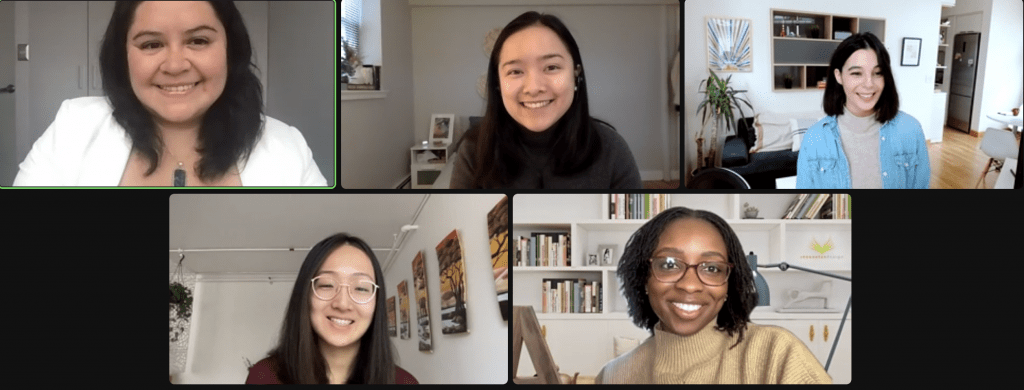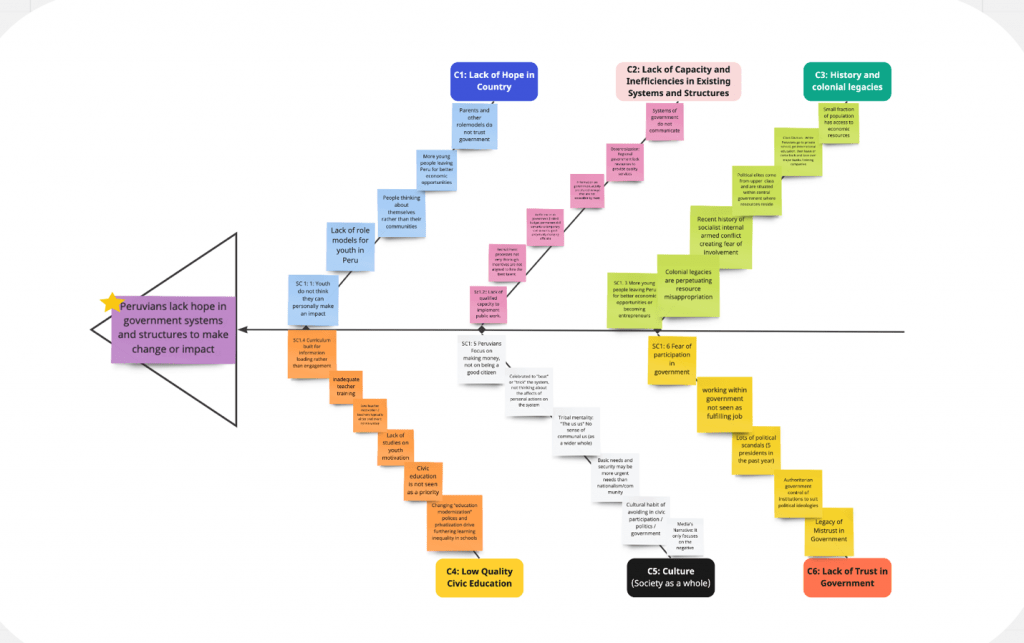Guest blog by Nicah Santos, Ivy Wang, Rachel Diaz, and Malaika Toyo

Six weeks ago, we came together because we wanted hands-on experience with a new approach to getting things done in development: PDIA. We were from all four corners of the world and campus – Filipino, Nigerian, Latin-American, and Chinese-Canadian, HKS and HGSE. We discovered that together, we had a wealth of combined experience in education, curriculum development, strategy, project management and Latin America. This would come in handy for our problem on civic education and youth political engagement in Peru.
Our first two tasks were on problem construction and deconstruction – they quickly became one of our biggest learnings from PDIA. Firstly, we realized that our authorizer who works for Impactful Development on a project “Peruanos en Accion” had defined the problem as the lack of a solution: “lack of civic education in Peru,” where civic education was already the presumed solution. But why was this a problem? We used the “5 Whys” approach and kept asking “why” to each answer, until we reached a formulation of the problem that answered “why does it matter”?
As we proceeded to the problem deconstruction, we realized that this problem’s causes were bigger and hairier than we had ever imagined – involving social norms, political corruption and ineptitude, and the legacies of a generation of internal armed conflict. At this point, we were tempted to give up, but we took heart in Salimah’s favourite chant: “one step at a time!” and Matt‘s advice: “just get it all down on paper, and don’t think ahead to the solution.” Looking back, they were right – and a lesson was to trust in the PDIA process.
After sharing our fishbone with the class, one comment that came up repeatedly was the creativity of the branches on the diagram. People were surprised that we even considered “culture” and “history” as root causes of our problem. We could identify these because we had been searching for the 1% to 3% of the big picture that our authorizer was missing. We understood that our authorizer, having already invested so much in her project and being proximal to the context, would know more deeply and broadly about the problem than we ever would. Our role was to reach into our networks, tap into our resources, and approach the issue with curiosity (curiosity that, perhaps, our authorizer no longer had towards a subject with which she is already so intimate) to find small but significant pieces of the puzzle.

The deconstruction process helped us realize that we actually didn’t have the right problem. That week, we went backward in order to move forward. We iterated on the problem statement, revisited the fishbone, and finally went back yet again to the problem statement. Our big takeaway here was that PDIA is not a linear process but a circular one, and problem construction and deconstruction in particular are linked steps that move together and improve in lockstep.
A Few Pieces of Advice
Our first piece of advice is to invest in teaming upfront – both within your PDIA group and with your authorizer; the dividends will be enormous. In our first class, we discussed the concept of “psychological safety”: feeling safe to share your ideas without holding back, and to disagree. For instance, a week after we had submitted our problem statement, one of us said “I think we were wrong,” – and we went back to the drawing board, ultimately crafting a more precise problem statement. We also made space to build a personal relationship with our authorizer, beyond a professional one. This allowed her to open up to us about her dreams and struggles, and be more honest about what was working and where we could improve.
As the adage goes: Trust the process. There is nothing to lose and so much to be gained from letting go of your old habits, biases, and judgments. Humility, curiosity, and kindness might not come easily to you. Things might move more slowly than you’re used to moving. Your fear of failure might creep in and tempt you to sacrifice learning for perfection. All these are barriers to you getting the most out of the next six crazy weeks. So try! Really try! Do PDIA as it’s designed to be done and reserve your judgment until the very end. You may just be surprised by how much you learn.
Lastly – have fun! When else will you have the opportunity to think deeply about one of the world’s most pressing problems, with a group of brilliant teammates and friends, guided every step of the way by an authorizer who will answer your silly questions and open doors for you? And all of this in a low-stakes environment with the world expert on PDIA basically “on call” just an email away. This is your moment. Own it.
This is a blog series written by students at the Harvard Kennedy School who completed “PDIA in Action: Development Through Facilitated Emergence” (MLD 103) in March 2022. These are their learning journey stories.
